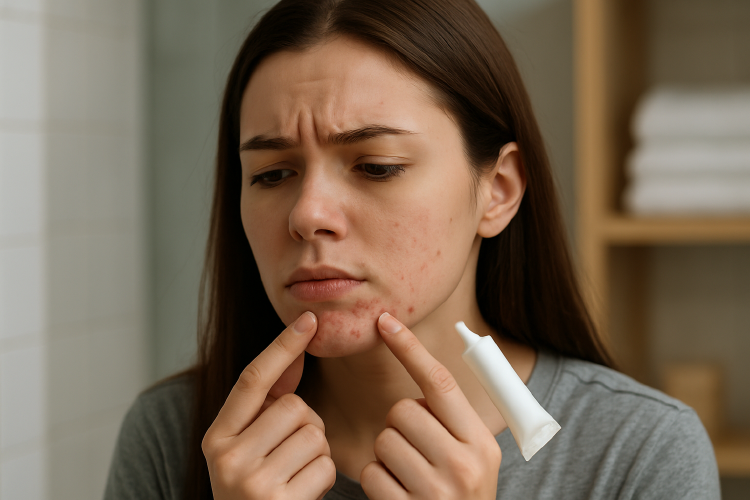Targeted Treatments for Persistent Chin and Jawline Acne
Discover the unique causes behind chin and jawline acne and explore effective strategies, from proven ingredients to optimized routines, to finally clear your skin in this tricky area.

- Seo Yuna
- 7 min read

Comprehensive Guide: Tackling Stubborn Chin and Jawline Acne
Experiencing persistent breakouts concentrated on your chin and jawline can be incredibly frustrating. This specific area of the face is unique and often requires a targeted approach beyond general acne treatments. If you find your primary acne concern is focused here, this guide is designed to help you understand the underlying causes and explore effective treatment pathways.
Having navigated this common challenge through extensive research, personal trials, and professional consultations, this information is compiled to offer a comprehensive resource. It aims to serve as a detailed starting point for anyone looking to gain control over their chin and jawline acne.
Important Considerations:
- Acne is highly individual. This guide provides general information and recommendations but may not cover every specific circumstance.
- This post is not intended as a judgment on personal habits or lifestyle.
- Conditions like rosacea, perioral dermatitis, or ingrown hairs from shaving can resemble chin acne but require different treatments. Consult a medical professional for accurate diagnosis.
- While based on thorough research, this information should not replace advice from a qualified healthcare provider.
This guide is structured to help you find the information most relevant to you:
- Types of Chin Acne
- Unique Causes of Chin and Jawline Acne
- Hormonal Acne Explained
- Effective Ingredients for Treatment
- Building Your Treatment Routine
- Fungal Acne Considerations
- Recovering a Damaged Skin Barrier
- Considering Professional Options
Let’s begin!
1. Types of Chin Acne
Acne on the chin, like elsewhere, can appear in several forms. Recognizing these can help inform your treatment approach:
- Blackheads: Open clogged pores that appear dark due to oxidation.
- Whiteheads: Closed clogged pores, appearing as small white bumps.
- Papules: Small, red, inflamed bumps without pus.
- Pustules: Inflamed bumps with a visible pus-filled center.
- Nodules: Hard, painful lesions deep beneath the skin’s surface.
- Cysts: Large, soft, painful, pus-filled lesions deep in the skin, often appearing as amorphous bumps.
2. Unique Causes of Chin and Jawline Acne
Beyond the general factors contributing to acne formation (oil production, clogged pores, bacteria, genetics, skin barrier issues, diet, and potentially certain B vitamins), the chin area has specific contributing elements:
- Gravity and Proximity to the Mouth: The natural downward movement of facial oils and debris, combined with bacteria from the mouth spreading outwards during daily activities like talking or eating, contributes significantly. Even minimal food residue can create a breeding ground for bacteria.
- Frequent Touching: This area is often unconsciously touched throughout the day, transferring bacteria and impurities from hands.
3. Hormonal Acne Explained
The chin and jawline are classic locations for hormonal acne. This link primarily involves androgen hormones, which increase sebum production. Oil-producing glands are sensitive to androgens, producing more oil when these hormone levels are higher or fluctuate (e.g., during menstrual cycles). This increased sebum, combined with dead skin cells and bacteria, leads to breakouts.
While hormonal imbalances can be addressed medically (consult a doctor about options like certain medications or birth control), managing the resulting oily skin environment with appropriate topicals is a key strategy for many.
4. Effective Ingredients for Treatment
Choosing the right ingredients is crucial for combating chin acne. Focus on those that promote cell turnover, control oil, fight bacteria, and reduce inflammation. Look for products containing:
- Retinoids (Adapalene, Retinol): Boost skin cell renewal to prevent clogged pores.
- Alpha Hydroxy Acids (AHAs): Surface exfoliants (like Lactic or Glycolic acid) that remove dead skin cells.
- Beta Hydroxy Acid (BHA - Salicylic Acid): Oil-soluble exfoliant that penetrates pores to clear blockages.
- Azelaic Acid: Anti-inflammatory, antibacterial, and mildly exfoliating. Helps reduce redness and bacteria.
- Niacinamide: Reduces inflammation and helps regulate sebum production. Note: some individuals may find this ingredient irritating.
- Benzoyl Peroxide: Antiseptic that reduces acne-causing bacteria. Effective but can be drying or bleach fabrics.
- Sulphur: Absorbs excess oil, exfoliates, and has antiseptic properties. A potential alternative for benzoyl peroxide sensitivity.
- SPF: Non-negotiable when using acne actives, as they increase sun sensitivity.
5. Building Your Treatment Routine
Patience and consistency are vital. It typically takes several weeks to see initial improvements. Starting new actives gradually is recommended to avoid overwhelming the skin and damaging the barrier, especially if you are new to these products or have otherwise clear skin prone to chin breakouts only.
Enhance Oral Hygiene
Consider incorporating rigorous oral hygiene, as the mouth’s proximity impacts the chin area. This might include daily tongue scraping, using mouthwash (allowing it to sit for a few minutes), thorough flossing (gum health is linked to certain bacteria), and rinsing with water after eating or drinking throughout the day.
Sample Routine Frameworks
Products can be applied just to the chin/jawline area or the full face depending on your needs and product instructions. Ensure consistent cleansing, moisturizing, and SPF application across the entire face.
Gentle Approach
- AM: Rinse with lukewarm water -> Niacinamide (optional, if tolerated) -> Azelaic Acid -> Gentle Moisturizer -> SPF
- PM: Gentle Oil/Balm Cleanse -> Gentle Foaming Cleanse -> Adapalene (Start 1-3x/week, increasing slowly) OR AHA (1x/week) -> Gentle Moisturizer
More Intensive Approach
- AM: Same as Gentle Approach.
- PM: Gentle Oil/Balm Cleanse -> Benzoyl Peroxide Cleanse (Rinse quickly or leave on briefly depending on tolerance) -> Adapalene (Start 1-3x/week, increasing slowly) OR BHA (1-2x/week) -> Gentle Moisturizer
Remember to introduce one new active at a time and allow your skin to adjust before increasing frequency or adding others. Some users find applying a gentle moisturizer before or after a retinoid (‘sandwich’ method) helps reduce irritation.
Pimple patches can be used as an adjunct treatment or for camouflage, particularly for pustules or cysts, but are not a standalone solution for widespread chin acne.
Makeup is generally okay in moderation, but ensure it is non-comedogenic and removed thoroughly as part of your evening double cleanse.
6. Fungal Acne Considerations
If traditional acne treatments aren’t yielding results, consider if you might be dealing with fungal folliculitis (often called ‘fungal acne’). This is caused by an overgrowth of yeast, not bacteria, and can appear as small, uniform bumps. Cleansing the area a few times a week with an anti-dandruff shampoo containing active ingredients like selenium sulfide or ketoconazole (leaving it on briefly) can be effective. Follow with a basic moisturizer.
7. Recovering a Damaged Skin Barrier
Aggressive use of actives can compromise your skin barrier, leading to dryness, redness, peeling, and even more breakouts as the skin tries to overcompensate with oil production. If your skin feels tight, irritated, or stings even with gentle products, scale back immediately.
Simplify your routine to basic cleansing and moisturizing until your skin recovers:
- AM: Rinse with lukewarm water -> Gentle Moisturizer -> SPF
- PM: Gentle Double Cleanse -> Gentle Moisturizer (Optional: add an occlusive balm on top).
Allow the barrier to heal before cautiously reintroducing actives one by one.
8. Considering Professional Options
If topical routines and lifestyle adjustments don’t fully clear persistent chin acne within several months, consulting a dermatologist is advisable. They can offer stronger treatments or compounded medications tailored to your needs. Discuss options like:
- Medical Grade Peels: Professional chemical peels.
- Prescription Topical Retinoids: Stronger versions like Tretinoin.
- Prescription Azelaic Acid: Higher strengths.
- Topical or Oral Antibiotics: Used short-term to reduce bacteria and inflammation, often followed by maintenance with retinoids or other topicals.
- Oral Isotretinoin: A potent oral medication for severe, resistant acne, requiring medical supervision.
When discussing treatments, especially oral medications or long-term plans like managing acne recurrence after past treatments (like Accutane courses) or considering future plans like pregnancy, have an open conversation with your dermatologist about your specific history and goals.
Addressing chin and jawline acne requires a targeted, patient approach. By understanding the unique factors at play and implementing a consistent routine with appropriate ingredients, significant improvement is achievable. Always prioritize skin health and consult with professionals when needed.
Unlock Your Healthiest Skin – Backed by Science and Personalization
Cosmi is your personal AI cosmetologist — offering tailored skincare recommendations and expert advice based on your unique skin type, concerns, and goals.
Visit Cosmi